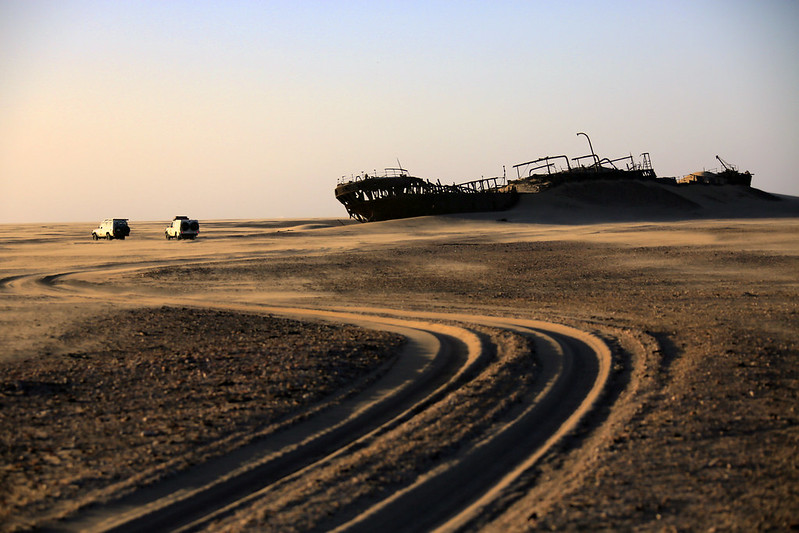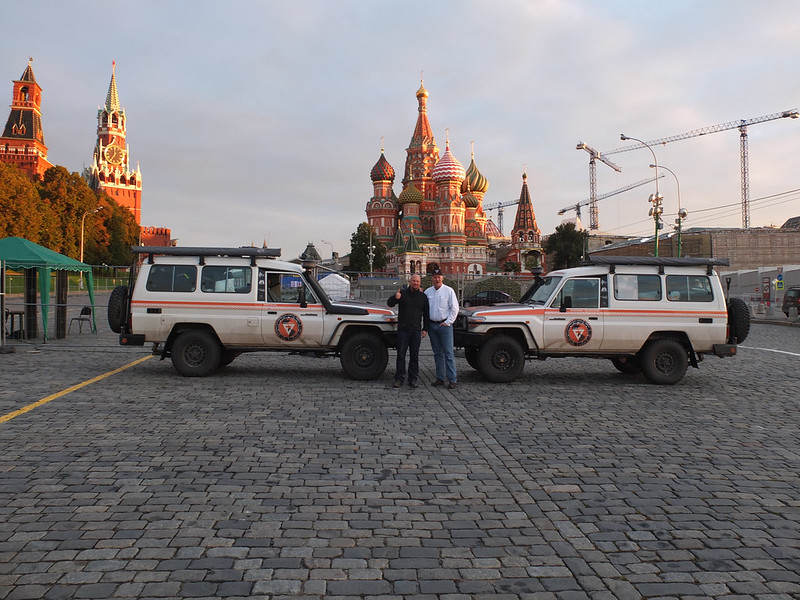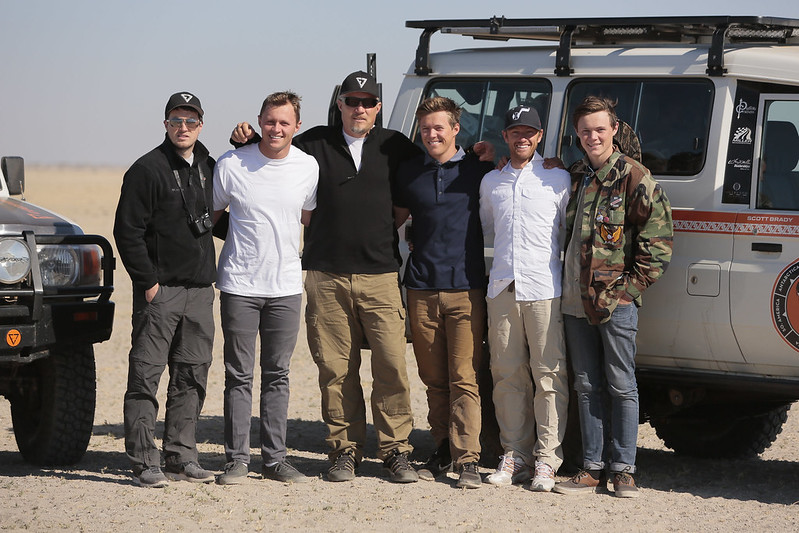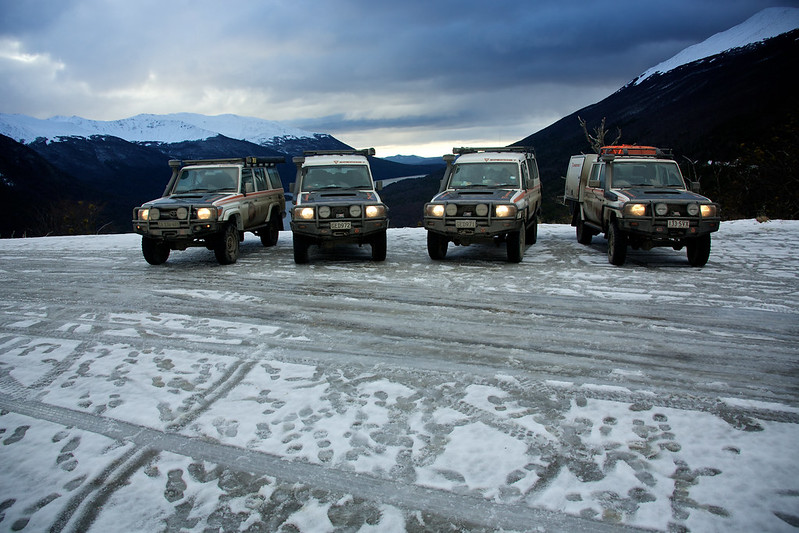TCT Magazine: What was the most exciting or scariest moment, or a couple of your favorites since I’m sure there are so many?
Greg Miller: One of the most memorable moments came on the Skeleton Coast. We had crossed the Namib Desert, in Namibia of course, and we’d pitched camp about one kilometer from the shore. It was all sand dunes, very little vegetation, so we had setup camp in this little niche out of a sand dune. There was a full moon that night, and I told the guys I was going to go for a little walk. I started walking toward the ocean and I thought for sure when I got there I’d see some lights. We could probably see 20 miles of coastline if I looked all the way north and all the way south, and who knows how far into the ocean I could see. There was not a single light to be seen anywhere, other than the moon, which was so bright I could see color. I just stood there for 30 minutes and tried to drink that moment in. There was this constant roar of waves crashing, kind of a dull roar. By the way, the water was about 600ft below us, and there was this huge slipface dune that went down to the water. The waves were lapping up against the face of that dune. I couldn’t see camp since it was behind another dune.. I was standing on this virgin sand dune, with a full moon bearing down on me. It was just this incredibly emotional moment. The solitude, the remoteness, it was probably the high point for me.
I think reaching the Ross Ice Shelf in Antarctica was very emotional for me, just because of the effort required to get there. The amount of planning, the physical effort to drive the vehicles - of course it came at a very high cost - but to actually realize the goal of traversing Antarctica was something I’ll never forget.
Another highlight for me was when we made it back into the US from Mexico, and we had our pickups with gooseneck trailers staged to ensure we were compliant with US laws to get the vehicles back. I wasn’t expecting it, but when I drove my 78 onto the trailer, I realized that was literally the end of the road. The adventure was over for that vehicle. When I turned the engine off there was a sense of finality, and it was a very emotional moment because of that finality. We were done. We were safe. The vehicles made it back relatively unharmed. We were now going to be able to travel on interstates at 75-80 mph, and of course the fact that we were going to be home and with our families again. On the other hand, there was this sense; it was almost like the death of a loved one, because that particular vehicle, the 78, that I had driven on all seven continents was going to be retired forever. As long as I own that vehicle (and I have no plans to sell it) it will never see another mile of adventure. Partly because it’s illegal in the US, but partly because there’s so much adventure equity built into it. If something happened to it, where am I going to get a vehicle that’s been on all seven continents? So it was a very intense, emotional moment for me.

TCT: Just hearing you tell that story really brings the gravity of that truck to light: It really is a museum piece: THE Land Cruiser that’s been on all seven continents.
So do you have plans for the other Cruisers then?
GM: Possibly. There are still a lot of adventures that I’d like to have. I’ve got the 76 and the 79, they’re super cool expedition rigs and they’re both perfectly outfitted for more adventure. I would say there’s a fairly high likelihood that at some point in the future I’ll ship those trucks overseas and do another adventure or two in them.
TCT: Cool, but nothing specific in the plans yet?
GM: Nothing specific, but one example related to Expeditions 7: we started in Prudhoe Bay, Alaska and came to Salt Lake City, then we also went from Ushuaia back to Salt Lake City. So we’ve covered the entire Pan American Highway. I’ve also been able to travel all the way across Antarctica and back, and I’ve been from Nordkapp, Norway (as far north as you can drive on a road) all the way down to Prague in the Czech Republic. So if I drove from Prague to Cape Town (South Africa), I’d have the entire circumnavigation longitudinally around the world, and I don’t know how many have done that. Another aspect of that, which is a real long shot right now: I’m entertaining the possibility of a geographic North Pole bid. I have the Hilux that we took to the South Pole, and I think that’d be the perfect truck to take to the North Pole. I’ve met a couple of guys that think they could get me to the North Pole and back safely, in spite of concerns about soft ice. So those are a couple examples of what might happen in the future, but right now it’s just talk.
TCT: Well, every good trip starts with a little bit of talk.
So obviously you carried a ton of gear with you, is there anything that stands out as the most important piece of kit that you had. Anything you couldn’t live without? (Other than the Land Cruiser, of course)
GM: I can give you three that I love: 1) My Nemo mattress pad, 2) Triple Aught Shell, 3) Sure Fire head lamp.
TCT: Did you carry any kind of pocket knives or something along those lines?
GM: We all carried a leatherman or pocket tool. Of course we had a couple of machetes, but never had to use them for defense.
TCT: I just wonder, since when I do any kind of trip I like to be really well equipped, but when I start thinking about border crossings I think: what can I afford to lose, what are they going to decide to confiscate.
Is there anything you think you would do differently from a planning perspective or a route perspective?
GM: From a planning perspective, I think we got it right. One thing I would change is that I’d have a scanner with me along with a printer, so I could effectively have my own copy machine at all border crossings. That would have saved a lot of aggravation. I would also have put greater emphasis on the culinary aspect of the trip. Scott Brady (my partner on the expedition) is a machine when it comes to food. He can go weeks, perhaps months without eating. And when he does eat, he can eat out of a box, bag, can or cellophane wrapper. For me, the way my body works, I need to have nutrition, and I can’t just eat Clif Bars forever. We didn’t really come around to that. There were so many moving parts that we didn’t really focus on culinary aspects until we got to Africa. My son Josh kind of took the reins from that standpoint and I hoped to be able to have some really neat dinners coming up through South America. I wanted a nice table, linen tablecloths, and I actually bought a couple of old kerosene lanterns so we could have kind of an iconic safari dinner. But it just never worked out. We were traveling too fast. There were too many deadlines. We kind of missed the culinary mark, and I do miss that about the trip. I think that would have lent a lot to the overall experience. So I’d definitely do that different next time.

Related Articles
As far as the route or timing, they were both pretty much right on. I think the route was right on for this project. We were a little late in South America and that was the result of some delays we had when I bought the 76 in South Africa and getting the paperwork handled. And the export was delayed. I would have rather done South America 45 or 60 days earlier, but that’s not that big of deal.
TCT: It’s interesting when we think about overlanding, people really want to focus on enjoying the countries. They’ll spend years on a South America trek and they’ll spend a lot of time really absorbing everything. Obviously that wasn’t the focus of E7, so other than culinary points, do you have any regrets not being able to spend more time in any of the areas?
GM: I can answer that both ways, yes and no. Yes, because we were moving very quickly and we weren’t able to really slow down and immerse ourselves in the culture as much as we would have liked. However, I’d say no because we were able to see a lot of this planet, given the amount of time we had to travel. So in my case, it really just whetted my appetite and gave me a sampler of places I want to go back and see (and there are many). Had we decided to just spend the 3-4 week window in a particular location, we would obviously have a better feel for that location, but we would have missed out on so much. There are those that have criticized us because we moved so quickly, but I’d say to them “you do it your way, we’ll to it ours.” I wouldn’t call it a regret, while I do wish we could have spent more time in those places, when I look at the experience in total, I don’t think I would’ve changed it.
TCT: Your family rotated through a lot of the different legs, it really seems like that was one of the main points of doing this journey was spending time with your family in these situations, and just exploring. Do you feel that was a positive as you hoped it would be? Or maybe even more so?
GM: I think it exceeded my expectations. I was able to have my wife (Heidi) join me for most of Europe and some of Africa and some of South America, which was great for me to spend that time with her. I had all three of my daughters participate in various segments, and most of that was one-on-one time. And then all of my sons and my sons-in-law were able to participate as well. One of the coolest things to me was that my youngest son, Oakley, was able to stand with me on all seven continents.

TCT: That’s really amazing, our kids are 16 months and 4-years-old, so we’re just in the beginning of that part of our adventure. Every time I see trips like this, and for us the entire idea of overlanding is about showing our children as much as we possibly can. Was the entire family ever there all at once?
GM: There was one point where they were, in South America. I had all of my kids and their spouses (I have three married children), and one of my grandkids was there as well.
TCT: I think that covers all the questions I had, do you have any other thoughts or stories about Expeditions 7 that we haven’t covered? Anything you really want to make sure our readers are aware of?
GM: While not everyone can do an expedition on the scale of Expeditions 7, my sincere hope is that our adventure will inspire others to do a trip like this within their own sphere. Something like a trip to Yellowstone can be amazing. Set aside excuses, quit talking about it, and go. Get in your car, bring family and friends, and “Go as big as your means will allow.” I really hope to inspire people to embrace that thought.
TCT: I think you come across as someone who’s truly interested in exploring and adventure, and I remember when I saw you speak last year, your story about going out with your dad when you guys lived in Colorado, in a Land Cruiser. To me, that’s the key for this, but instead of enjoying time together watching TV, enjoy time together headed down the trail.
GM: To that point, one of the things that came into focus for me very clearly during E7, is that vehicles are the best mechanism I know for building friendships and relationships. You just referred to a moment with me that was great with my dad, in a 55, and others in Mustangs and Cobras. Those moments that were centered around a car were very memorable and poignant moments. I look back on how true that is with my friends in high school, and college years, and now the experiences I’ve had with my kids in Land Cruisers and other cars, and what it’s done to strengthen our bonds. That, to me, is the magic of cars, and the magic of having experiences that cars provide.
TCT: It’s that bonding experience that can really bring us together. I’m very inspired Greg and thank you so much for your time. It’s been great talking to you and I look forward to hearing more about these adventures in the future.
To learn more about Expeditions 7, see more photos and videos at www.expeditions7.com
More Photos:
[flickr set=72157650459801580]
To get your copy of the
January 2015 issue:
FIND US ON:









